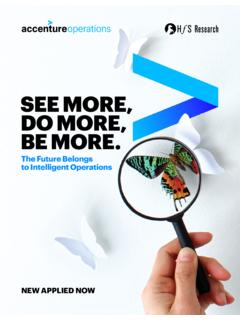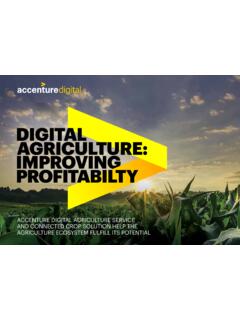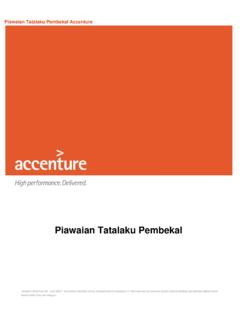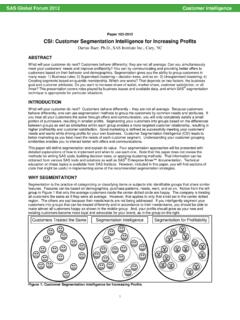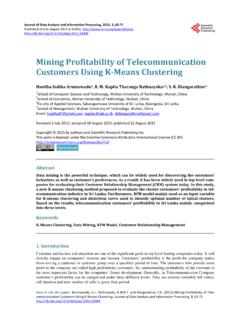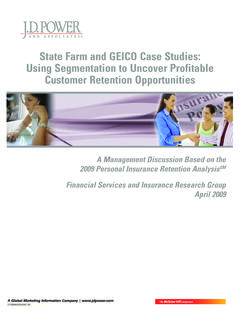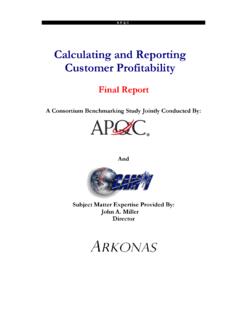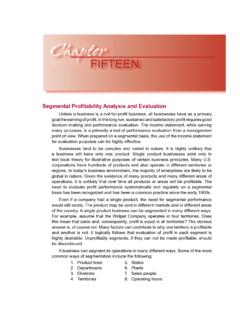Transcription of OGAN KOSE MIGUEL GONZALEZ-TORREIRA RICHARD …
1 OGAN KOSEMIGUEL GONZALEZ-TORREIRARICHARD MYERSCOUGHIn this day and age, making decisions that are uninformed or not driven by data is almost irresponsible. The digital world generates a wealth of insights and increasingly sophisticated tools to turn data into decisions. Yet not all industries are putting digital to good use and it is hurting their bottom downstream energy. Companies are leaving money on the table by basing business decisions on gut feelings that are supported by facts, not driven by them. Granted, the deep level of expertise that exists among industry leadership makes for good instincts, but some executives favor instinct over information. This is especially dangerous in an increasingly dynamic and competitive industry. Energy companies that do not take advantage of digital insights are missing a real opportunity to drive commercial value chain optimization with an end-to-end view across all downstream players. Most downstream companies tend to operate each aspect of the business in discrete siloes without ample consideration for the interdependencies of the overall value chain.
2 DIGITAL HAS THE REAL POTENTIAL TO MAKE MONEY FOR THOSE WHO ADOPT IT AND PENALIZE THOSE WHO DON T. 2 FROM CRUDE TO IMPROVEDE nergy companies are accustomed to responding to fluctuating markets. Many downstream operators have gotten quite good at cutting costs. Addressing areas like resourcing, organization design, selling off assets and rethinking risk appetites has created leaner operations. Yet these things are not enough. A primary focus on cutting costs has prevented most oil executives from seeing the potential growth opportunities in digital. Traditionally, downstream organizations work independently, each with its own technology and process infrastructure and often with limited integration. Some are more sophisticated with bespoke data architectures. Others work from Excel spreadsheets. Most organizations are not set up to communicate effectively across the enterprise, to provide marketing with insight on what the refinery is producing, for example, or to help structure supply and purchasing contracts that maximize integrated margin across the value chain.
3 That is where digital capabilities come in, connecting the pieces to drive better siloed situation reinforces an operating model in which business units are not optimally set up to think about the impact of their decisions across the business. Rather than operating as a team, there is risk that each unit is playing its position according to specific goals. This may lead to uneven results. Accenture Strategy analysis of client experiences from the past five years shows that poor integration in decision-making processes among refining, supply, trading and marketing can result in EBITDA loses due to ill-informed pricing decisions across the value chain. Digital interventions across the value chain could realize an uplift of up to 10 percent (see Figure 1). ALL COSTS HAVE BEEN CUT NOW WHAT? 3 FROM CRUDE TO IMPROVEDTIME TO LOOK AT DIGITAL4 FROM CRUDE TO IMPROVEDFIGURE 1 VALUE CHAIN POTENTIALSTORAGE & INVENTORY OPTIMIZATIONSUPPLY-DEMAND & PRICE FORECASTINGCUSTOMER segmentation & MARKETINGPRICING & CONTRACT OPTIMIZATIONPROFIT-AT-RISK OPTIMZATIONO ptimize inventories for a real-time view of current stock levels combined with supply and demand analytics.
4 Reduction in inventory cost1 3%Generate accurate and rapid forecasts using advanced analytics that incorporates internal and external data feeds. Margin uplift2 5%Drive optimal customer allocation by segmentation based on aggregation of big-data ( customer buying patterns, price sensitivity, market trends). Revenue uplift1 5%Incorporate multiple data feeds to identify optimal pricing and contracting uplift1 2%Drive commercial optimization using a risk analytics engine driven by aggregation of large data sets on internal and external risks factors. Reduction in risk capital5 10%DIGITAL AREADESCRIPTIONVALUE POTENTIALS ource: Accenture Strategy client experience and FROM CRUDE TO IMPROVEDD igital connectivity brings data from all areas of the value chain into one platform for advanced analytics. As a result, downstream energy companies can query and visualize data, generate insights, drive fact-based actions and maximize profit. While many units have systems to understand their own part of the operation, few downstream companies have the ability to look across the business.
5 Executives are investing in digital to optimize operations like maintenance turnarounds, and using sensors and visual analytics for health and safety. However, commercially-optimized decisions across the value chain have yet to reap the full benefits digital can a trader receives news that there is distressed cargo available at a discount. Downstream value chains are not set up to assess the implications of buying this cargo from an integrated margin perspective. Most companies today rely on the feelings and instincts of experienced executives to make such decisions. They hope the impact will be positive, but do not have control over all the facts to ensure a good outcome. Figure 2 shows the various dependencies, and how all can be quickly and effectively brought into the decision process. Digitally-enabled, integrated value chains can reduce the time it takes to make these types of decisions while producing better and more predictable results. In the scenario above, a digitally-enabled downstream value chain could give the right people the required data to contribute to and make optimized decisions.
6 Another benefit to the integrated value chain is that decisions can be pushed deeper into the organization. Rather than relying on the instincts of a couple of experienced executives, now middle managers with deep content knowledge or keen analytic skills can contribute to a better SHIFTS DECISIONS FROM FEELINGS TO FACT 6 FROM CRUDE TO IMPROVEDS ource: Accenture TRADERPRODUCTS TRADERMAINTENANCEMANAGERRISKMANAGERMARKE TING/ SALESCRUDE TRADERCOMMERCIAL OPTIMIZERR eceives information about a distressed cargo opportunitySTORAGE & INVENTORY OPTIMIZATION SUPPLY-DEMAND & PRICE FORECASTINGCUSTOMER segmentation & MARKETING PRICING & CONTRACT OPTIMIZATION PROFIT-AT-RISK OPTIMIZATIONUses embedded optionality in existing contract to increase volumeRe-plans for catalyst change out delay to adjust to new planChecks impact on profit- at-risk and recommends any required mitigationsAdjusts price strategy to absorb part of the additional productCloses deal to capture valueUses digital optimizationplatform to analyze and validate that the new plan will yield a higher integrated marginFIGURE 2 DIGITAL OPTIMIZATION7 FROM CRUDE TO IMPROVEDC ompanies with optimized value chains will need a different breed of downstream leadership.
7 Successful leaders in the evolving downstream energy industry will need to understand how to interpret and trust analysis and recommendations from machines to make judgement calls and decisions. Successful leaders of the future will need to trust the people in their organizations more as well. Decisions driven by data and insights can be pushed further down into the organization, where people have enough solid information and insight to act and react with confidence. This change in mindset has the potential to transform the way downstream energy players operate and put emphasis on collaboration and people development. Accenture Strategy and the Accenture Institute of High Performance researched skills that digital leaders will need in the future. They found that an effective digital leader will find the balance of tasks shifting from scheduling resources, planning work and tracking results to managing people and relationships (41 percent), experimenting (34 percent) and coordination (25 percent).
8 1 New metrics and incentives will help to drive the necessary behavioral shift and encourage better business thinking. DOWNSTREAM LEADERSHIP SKILLS WILL NEED SOME REFINEMENTTHE NEW DIGITAL LEADERSHIP41%34%25%MANAGING PEOPLE AND RELATIONSHIPSEXPERIMENTINGCOORDINATION8 FROM CRUDE TO IMPROVEDSO FAR NO DOWNSTREAM ENERGY ORGANIZATION HAS MASTERED A DIGITALLY ENABLED VALUE CHAIN. HOWEVER, WHEN LOOKING ACROSS DOWNSTREAM PLAYERS, POCKETS OF EXCELLENCE CAN BE FOUND:AN END-TO-END, COST-TO-SERVE VIEW provides a better understanding of how to set the internal transfer price with marketing. The resulting real-cost visibility and the capability to move to a dynamic transfer pricing mechanism is helping to improve competitiveness and DIGITAL PLATFORM aggregates and performs analytics on data from sources as diverse as supply contracts, depot inventories and individual retail stations. This provides enhanced visibility and analytics on core margin drivers such as cost to serve, pricing, and customer segmentation .
9 profitability improves by ensuring end-to-end downstream offerings precisely align to customer INITIATIVES across the value chain are bringing down the cost to serve while increasing profitability . Sensors identify volume leakages across the logistics network. Integrated scheduling tablets and a fleet management control tower create efficient product movement across the supply FROM CRUDE TO IMPROVEDWith deeply embedded knowledge, long-established processes and many moving parts, changing the value chain in a complex industry such as downstream oil and gas can seem daunting. Yet companies of every size can start taking a few simple steps toward reaping the benefits of a digital organization. IMPLEMENT DIGITAL TECHNOLOGY to connect all relevant downstream data sources into a centralized platform for ongoing analysis. This entails integrating each part of the business into an agreed-upon platform. This is no easy task, but is a prerequisite to enabling a digitally-driven value chain.
10 Additionally, many energy companies do not have full control over the supply chain, with distribution networks owned by partners. Instead of bringing operational data onto the platform, optimization requirements should be built into transfer pricing agreements and commercial constructs between the different parties. That way, energy companies have leverage to effect changes when required for the purposes of commercially optimizing AN ANALYTICS BLUEPRINT with appropriate business logic to generate insights and drive actions at any given time across the value chain. Digital collaboration tools can provide access to an analytics platform that informs integrated, data-driven decisions, but not without a plan for fitting the pieces together. An effective blueprint would incorporate pre-configured analysis around price elasticity, integrated customer profitability analysis, trading analytics, cost of contractual constructs, fleet and inventory optimization and more. Many of these models already exist within an organization, but the blueprint helps align them to drive effective processes and decisions, using the output from one area as the input to DOWNSTREAM INTO THE DIGITAL AGE10 FROM CRUDE TO IMPROVEDPREPARE/RETRAIN EXECUTIVES for agile decision-making and evolved roles in the emerging downstream of the future operating model.

